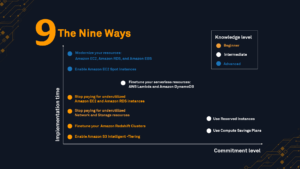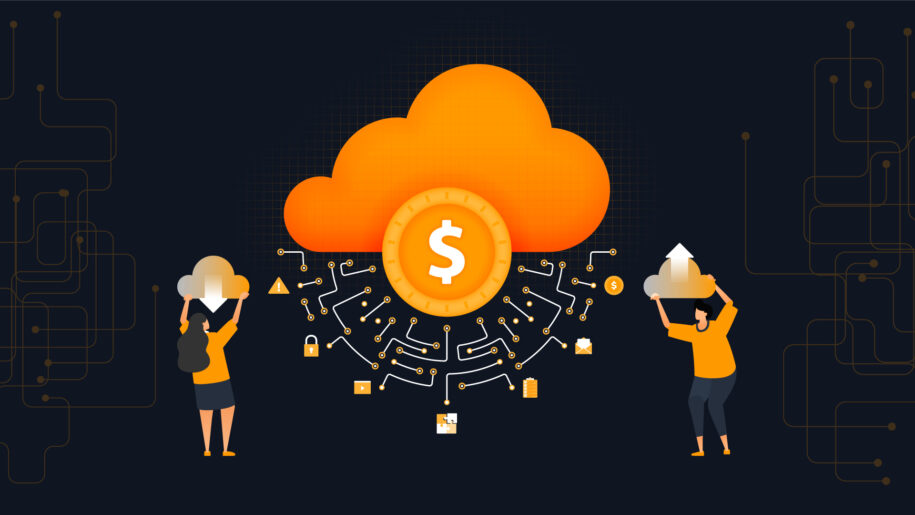AWS provides a wide range of services and pricing options that allow modern organizations to manage their costs effectively while meeting business requirements for performance and capacity. The process of AWS cost optimization involves monitoring your costs and usage, analyzing the data to identify potential savings, and taking action to achieve those savings.
This may come across as fairly seamless, but there is more than meets the eye. Businesses may take some time to get familiarized with AWS optimization and find appropriate tools and resources for their specific requirements. For this purpose, let us cover the tricks of the trade and understand AWS cost optimization best practices and crucial tips.
Organizational Pain Points & Expert Remedies
Before giving you some tips and tricks on how cost optimization in AWS works, let’s skim the top three questions and worries of leading enterprises.
How to Initiate AWS Cost Optimization Process?
To optimize your cloud costs, it’s vital to start using a two-stage prioritization framework.
- Prioritize tasks based on implementation time, commitment level, and knowledge required.
- Choose more manageable tasks such as computing right sizing, scheduling, waste removal, Amazon S3 cost optimization, and Intelligent Tiering.
- Assess potential risks and savings by focusing on non-critical environments like development, staging, and testing.
- Focus on initiatives that bring the highest savings in the shortest time possible.

• Business Agility & Its Value
The value a business agility model brings along is worth giving a shot at. Not only does it offer greater freedom of choice for management but also to the teams at an individual level. With an appropriate and timely flow of information, an organization can do wonders, and that is what business agility offers – the knowledge of change followed by immediate action capabilities.
AWS Spending – Limit & Usage Realization
To maximize the return on investment for your cloud expenses, it’s essential to focus on ‘Usage’ and ‘Rate.’
- For ‘Usage,’ it’s crucial to have transparency and accountability to ensure your organization only utilizes what is required and effectively manages the cloud’s elasticity.
- It can be achieved through computing the right sizing, scheduling non-critical workloads, fine-tuning services, and eliminating unnecessary waste.
- When it comes to ‘Rate,’ there are numerous opportunities to pay less for what enterprises use by exploring modernization options.
- Like AWS Graviton, utilizing unused compute capacity with Amazon EC2 Spot, and committing to stable resource usage through AWS Compute Savings Plans and Reserved Instances.
Check out 8 Reasons Why Amazon Web Services are Driving Small Businesses Towards Industrial Change to understand how SMBs can leverage their power while managing overall spending.
Manage Sky Rocketing Costs with AWS Modern Tools
Experience AWS trusted advisor cost optimization by managing overall spending. Enterprises need to have discipline and a good understanding of the tools available to them. AWS offers several tools that can help control and manage costs, including:
AWS Cost Explorer
This tool provides a comprehensive view of your cloud estate, including “what,” “when,” “who,” and “how” much you’re spending. It also provides valuable recommendations for right sizing and optimizing reserved instances and savings plans based on your historical usage.
AWS Budgets
Once businesses have gained visibility into their costs and initial optimizations in place, AWS Budgets allow brands to set specific budget thresholds. This triggers automated actions such as notifications, increased restrictions, or resource shutdowns, helping them avoid surprises and maintain control over your AWS spending.
AWS Cost Anomaly Detection
For even greater visibility and control, AWS Cost Anomaly Detection uses advanced machine learning algorithms to identify anomalous spending and root causes. With three simple steps, you can set up a customized monitor and receive alerts whenever unwanted spending is detected.
AWS Cost Optimization: Top Tips and Tricks You Need to Know!
Now let’s get to the point! We will walk you through 10 tactical tips you can utilize today to reduce your AWS cost.
1. Identify EC2 Instances & Reduce Costs by Right Sizing
- To save costs on AWS, check for idle or underutilized EC2 instances using AWS Cost Explorer Resource Optimization. You can either stop or downsize these instances.
- To automate stopping instances, organizations must use AWS Instance Scheduler.
- For automatic resizing based on Cost Explorer’s recommendations, use AWS Operations Conductor.
- If you want to optimize instance types beyond downsizing within a family, use AWS Compute Optimizer.
- It offers recommendations for downsizing within or across families, upsizing to remove performance issues, and instances in an Auto Scaling group.
2. Analyze EBS Volume, Reduce Cost by Snapshotting, and Delete it!
In the AWS cost optimization best practices, analyzing EBS volume is vital. To save overall costs, it’s essential to identify Amazon EBS volumes that are not being used often and delete them. You can do this by checking the Trusted Advisor Underutilized Amazon EBS Volumes and looking for volumes with less than 1 IOPS (Input/Output Operations Per Second) per day over 7 days. Before deleting them, taking a snapshot of the volume is recommended in case it’s needed later. You can automate this process by using the Amazon Data Lifecycle Manager.
3. S3 Cost Optimization by Leveraging Lower Cost Storage Tiers
Utilize S3 Analytics to assess storage access patterns for object data over 30 days or more. The tool provides suggestions on minimizing expenses by utilizing S3 Infrequently Accessed (S3 IA) and enabling businesses to automate moving these items to a more cost-effective storage tier through Life Cycle Policies. Additionally, organizations can opt for S3 Intelligent Tiering, which automatically analyzes and transfers your objects to the appropriate storage tier.
4. Identification of Amazon RDS & Redshift Instances While Reducing Cost by Stopping RDS & Pausing Redshift
If you want to cut costs, use the AWS Trusted Advisor cost optimization feature on Amazon RDS and Redshift to identify idle instances.
- For RDS, identify instances that have not been connected in the last 7 days.
- Use the Underutilized Redshift clusters check for Redshift, which identifies clusters with no connections in the last 7 days and less than 5% CPU utilization for 99% of the previous 7 days.
After analyzing these, stop RDS and pause the performance of Redshift to reduce overall cost and achieve efficiency.
5. Analyze Amazon DynamoDB Use & Reduce Cost by Autoscaling
To keep track of your DynamoDB usage, you can monitor two metrics:
- Consumed Read Capacity Units (RCU) and Consumed Write Capacity Units (WCU) using CloudWatch.
- Businesses can opt for the option where their DynamoDB table can automatically scale in and out. This is achievable with the AutoScaling feature.
- Alternatively, you can opt for the on-demand option, which allows you to pay for read and write requests based on usage, making it simpler to manage costs and performance.
6. Networking & Reduction in Costing by Eliminating Idle Load Balancers
Another AWS cost optimization best practice is to analyze the networking patterns. To reduce the costs through it, enterprises can use the Trusted Advisor Idle Load Balancers check. This will identify load balancers with a Request Count of less than 100 in the past 7 days and delete them using the steps provided.
Organizations can refer to AWS Cost Explorer to review their data transfer costs. If data transfer from EC2 to the public internet is expensive, Amazon CloudFront can be used to cache images, videos, or static web content at AWS edge locations worldwide, eliminating the need for over-provisioning capacity for potential spikes in traffic.
7. Amazon EC2 Spot Instances Can Reduce EC2 Costs
Do you have a workload that can’t handle interruptions? If so, consider using Spot instances to save up to 90% on costs. We know it might sound bizarre, but reducing EC2 costs with EC2 Spot Instances is possible.
With EC2 Auto Scaling, you can launch both On-Demand and Spot instances to reach your desired capacity. Auto Scaling automatically requests Spot instances and maintains your target capacity even if your Spot instances are interrupted.
Workloads that can handle interruptions include big data, containerized workloads, CI/CD, web servers, high-performance computing (HPC), and test & development workloads.
8. Modification of EC2 Autoscaling Groups Configuration
- To make the most of your EC2 fleet, review and adjust the configuration of your EC2 Autoscaling group.
- Check your scaling activity through the describe-scaling-activity CLI command or follow the steps on the console.
- Analyze the data to see if the scaling policy can be optimized to add instances less aggressively.
- You can also reduce the minimum fleet size while serving end-user requests effectively.
9. Usage of RI to Reduce RDS, Redshift, ElastiCache, & Elasticsearch Overall Costs
Reserved Instances are powerful for cost optimization in AWS. Businesses can reduce RDS, Redshift, ElastiCache, and Elasticsearch costs using one-year, no upfront Reserved Instances (RI).
This can provide up to 42% discount compared to On-Demand pricing!
AWS Cost Explorer RI purchase recommendations can help enterprises make the best use of RIs based on their usage. Brands must adjust the parameters to one year, no upfront.
10. Compute Savings Plans can Reduce EC2, Lambda, and Fargate Costs
Compute Savings Plans can also help reduce EC2, Fargate, and Lambda usage costs. These plans automatically apply to your usage regardless of instance family, size, AZ, region, OS, or tenancy.
You can get up to 54% discount compared to On-Demand pricing with one year, no upfront Compute Savings Plans.
AWS Cost Explorer can provide recommendations based on your usage. Once you sign up for Savings Plans, your use will automatically be charged at discounted prices. Any usage beyond your commitment will be charged at regular On-Demand rates.
A one-year commitment is required, but the break-even point is typically seven to nine months.
Lowering Costs with Secret Tips of AWS Cost Optimization
Using AWS services is phenomenal for your business. With incredible flexibility, enterprises can effectively manage their workload. However, the cost may skyrocket, drilling holes in your pocket. By following AWS cost optimization best practices, you can efficiently manage the costs without compromising performance. After all, who wants to pay extra when there is a way to spend less?
This is your call to explore options that can help to transform your businesses and save through the incredible AWS cost optimization tools by connecting with NETSOL. Our experts are ready to take your businesses off the ground with reduced-cost options, helping you pay only when required. Contact us today, and let’s begin your business transformation with AWS!


Leave a Reply